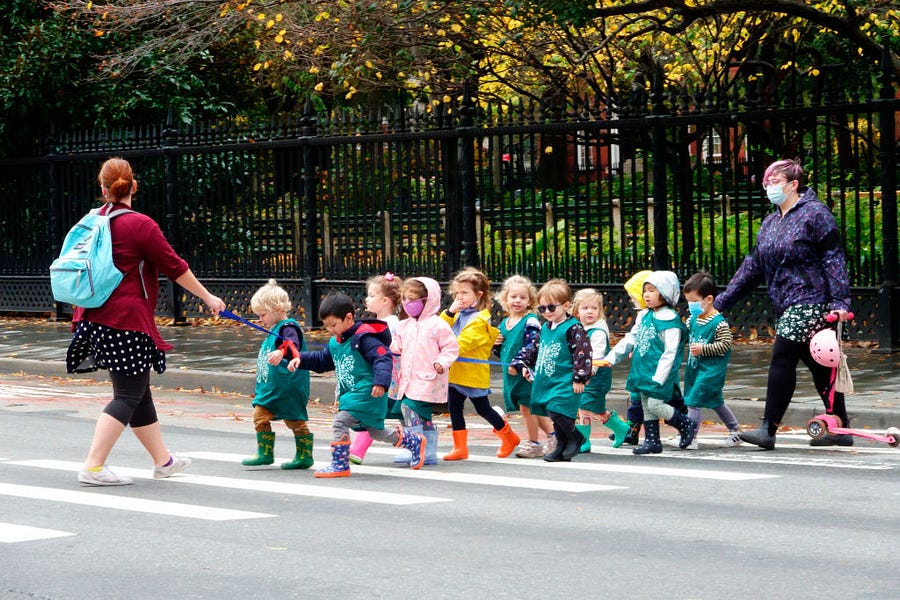Last week, a couple hundred “nonprofit organizations, business leaders, and women’s advocates” took out a full-page ad in the New York Times to quixotically insist that Congress pass the (very, very dead) Build Back Better Act. Tellingly, the ad led with the ever-popular demand that Congress enact “universal preschool for all 3- and 4-year-olds.”
It made sense to lead with preschool. Heck, it may be the piece of Build Back Better that Sen. Joe Manchin most consistently embraced last fall. And it’s easy to understand why. Good, reliable child care is crucial for harried parents of young kids, especially in an age when aunts, uncles, and grandparents are less likely to live nearby. It empowers moms who want to work, an issue that’s taken on added urgency as COVID-fueled disruptions have driven more than 1 million mothers out of the workforce. And good pre-K schooling can make a big difference for some kids. Reliable, trusted, convenient preschool is a terrific thing.
Unfortunately, that’s not enough for today’s Democrats, who’ve sought to turn pre-K into a sacrament. Having concluded that the existing web of preschool options is too uneven, that some providers don’t pay caretakers enough, that some centers are affiliated with churches that hang fast to pre-woke doctrines, and that the whole system is just, well, too damn messy, they’ve set out to remake the world of preschool in the image of K-12 public schooling.
They dream of a vision of universal preschool that deemphasizes or displaces today’s web of mom-and-pops, church-sponsored offerings, and the rest in favor of something that looks more like Bill de Blasio’s signature mayoral accomplishment—effectively tacking an extra grade on the front end of New York City’s expensive, unionized public school system. De Blasio’s model has undercut small, community-based or charter providers, which receive $9,800 per pupil even as the school district’s preschool programs get two to three times that amount, while putting pre-K on a K-12 calendar, subjecting it to the vagaries of union contracts and school closures, and moving kids out of neighborhood settings and into school buildings.
Of course, if one sits down with preschool aficionados, they’ll patiently explain that this isn’t about a love of regulation, unions, bureaucracy, or bloat—it’s just the evidence-backed way to deliver quality preschool, and they’ve got the science to prove it.
As for that science. Well, just last month, researchers at Vanderbilt University released the results of a new study of the “Tennessee Voluntary Pre-K program,” launched statewide back in 2009. The study has been billed as “the nation’s only thorough, ongoing investigation into the impacts of a statewide pre-K program for economically disadvantaged children using a random sample.” The initial 2015 report disappointed, finding that the benefits of the pre-K program faded by the end of kindergarten. The follow-up findings are even bleaker. In tracking the 1,852 students randomly assigned to pre-K against a control group, the researchers found the pre-K group had lower state test scores than their peers, in grades three through six, and experienced worse outcomes “for disciplinary infractions, attendance, and receipt of special education services.”
Readers who regularly hear that pre-K “works” might be surprised. They shouldn’t be. The truth is, an analysis of the 10 best-known, widely cited pre-K programs makes clear that the research around these programs shows not so much “that ‘pre-K works’” but that “some early childhood programs yield particular outcomes, sometimes, for some children.” Indeed, the most reliable research has suggested that “the most meaningful, far-reaching effects” are the product of “carefully designed, well-implemented programs”—not sweeping mandates.
Take the federal Head Start programs, which aim to prepare “America’s most vulnerable” 3- and 4-year olds for academic and social success. In 2015, the federally supported What Works Clearinghouse found that, of the 40 studies examining the effects of Head Start, just one met baseline standards for rigor. That study, conducted by HHS and released in 2010, found modest evidence of a positive impact on reading and “no discernible effects” on math achievement. That’s a fairly weak track record for a half-century old program that received more than $10 billion in federal funding last year.
What’s going on? Well, when something like early childhood education “works,” it’s typically because of how the elements work in concert. This is frustrating for advocates who want to offer big solutions and for researchers who want to deal in certainty—who want to declare, based on careful data collection and high-powered regressions, what works and what doesn’t.
Consider the famed Perry Preschool project, a small pilot preschool and home-visiting program for 3- and 4-year-olds that ran from 1962 to 1967 in Ypsilanti, Michigan. The program provided 58 low-income black children with two years of a research-based preschool curriculum and weekly home visits. It was found to have positive impacts on participants’ educational and life outcomes, reducing teenage pregnancy and increasing lifetime earnings. All good stuff. But note that we’re talking about less than five dozen students, more than a half-century ago, in an intensive boutique program. The idea that Perry offers a roadmap or incontrovertible proof to justify billions in federal spending is goofy.
And yet, several years back, Nobel Prize-winning economist James Heckman savaged George Will for questioning the benefits of expanded pre-K education. Early childhood education clearly works, Heckman insisted, based on his “evidence-based analysis of more than 30 years of data” from the Perry Preschool project. “It is as good a trial for effectiveness as those we currently rely on to evaluate prescription and over-the-counter drugs,” he wrote.
Heckman is a very smart guy, but he got this one wrong. The trial for preschool effectiveness tells us much less than drug trials do. Unlike a preschool program, the ingredients of an over-the-counter drug can be replicated exactly and administered to new patients with precise directions. The difference between a medical therapeutic and a public policy response should be painfully evident to anyone who’s watched researchers struggle to gauge the health care benefits of cloth masks or six-foot social distancing during the past two years.
Preschool programs are a lot more like a social distancing regimen than a vaccine, in that the “treatment” can be pretty fuzzy. (If social distancing “works,” does that mean three feet or six feet? Does it matter if you’re inside or outside?) In the case of the Perry Preschool project, it’s not especially clear just what preschool advocates are bent on replicating. Was the intervention simply being able to attend a preschool? Was it attending any “high quality” preschool? Okay, but just what was it that made the Perry preschool “high quality”? Was it student-teacher ratio? The home visits? The curriculum? All of these? None of these? How exactly does one make that determination?
Unfortunately, pre-K advocates have a habit of eschewing such questions in order to lunge for the biggest, most obvious policy levers they can find. In the case of Build Back Better (BBB), the federal government would supersize federal preschool spending via an “open-ended funding structure” (in the felicitous phrasing of the Center for Law and Social Policy), while imposing new federal requirements governing preschool education standards, mandating that salaries for preschool staff match those of elementary educators, and dictating that only individuals with a bachelor’s degree can be hired as lead preschool teachers. The result would bureaucratize early childhood education, burden small church-based and neighborhood providers, drive up costs, and aggravate staffing challenges—all in the blind assurance that 3- and 4-year olds will be better off if preschools operate more like K-12 school districts.
Along the way, BBB’s mandate would have some devastating consequences on the provider ecosystem. Today, the majority of families who use center-based care rely on faith-based providers, which are eligible for federal funding, alongside a bevy of public and private providers, through the $10 billion, bipartisan Child Care Development Block Grant. The House version of Build Back Better would’ve put an end to that, restricting the eligibility of faith-based providers. Meanwhile, even the hard-left People’s Policy Project has calculated that BBB’s eligibility cutoffs would price many middle-class families out of affordable childcare “while providing no benefits to the poorest and most vulnerable children.”
Indeed, the Manhattan Institute’s Robert VerBruggen has noted that BBB’s childcare subsidies and preschool provisions would distort parental choices about child-rearing by wiping out “the financial savings that stay-at-home parenting normally brings.” This is a revealing choice by the Biden White House, given that the majority of lower-class (58 percent) and working-class (68 percent) couples say they’d prefer to have one parent be at home full-time.
Technocratic policymaking frequently stumbles when it comes to schooling, where relationships, trust, and context loom large. This was very much in evidence during the past decade-plus as one major technocratic education project after another disappointed: including complex new K-12 teacher evaluation systems, the Common Core K-12 standards, and the multibillion dollar federal K-12 School Improvement Grant program. Regrettably, rather than prompt much in the way of reflection, this litany has driven self-assured progressive advocates, pols, and philanthropists to race away from their failures by pivoting to a new frontier—early childhood education.
But if technocrats couldn’t figure out how to evaluate teachers, write useful standards, or improve failing schools, it’s tough to imagine why any fair-minded observer would imagine they’ll do better when it comes to preschools—which are engaged in a less technical, more formative project.
While we should indeed work to make early childhood education more accessible, there are better ways to do it. The Child Care Development Block Grant is a valuable program and expanding it is a smart, sensible idea with a lot of bipartisan backing. There’s a strong case for providing tax breaks to parents and guardians wrestling with early childhood expenses. And there’s a lot of room for state, community, and philanthropic activity to support employers who offer childcare benefits to employees.
Helping ensure that families have access to reliable, trusted child care options is a good idea. The problem is that the claims made about preschool—and especially about universal pre-k—tend to be overstated, the benefits are far from certain, and massive new programs can cause real harm. There’s much that can be improved in early childhood education, but there’s also much that’s good. Would-be reformers need to be careful not to break what’s working in the name of suspect science.






Please note that we at The Dispatch hold ourselves, our work, and our commenters to a higher standard than other places on the internet. We welcome comments that foster genuine debate or discussion—including comments critical of us or our work—but responses that include ad hominem attacks on fellow Dispatch members or are intended to stoke fear and anger may be moderated.
With your membership, you only have the ability to comment on The Morning Dispatch articles. Consider upgrading to join the conversation everywhere.